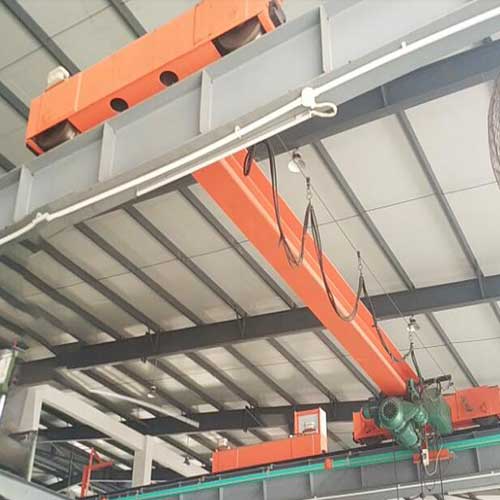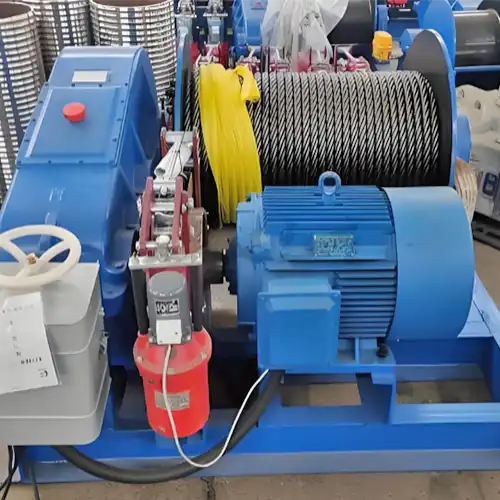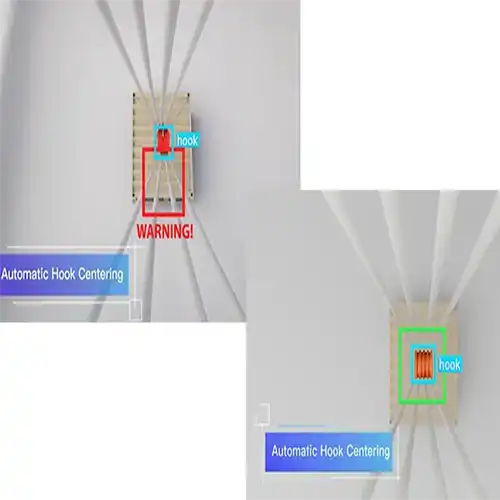Indoor Overhead Cranes, Affordable Material Handling 5 - 80 Ton
Indoor overhead crane for sale. Custom indoor overhead cranes & bridge cranes for various types of material handling, cost-effective indoor crane system.
Category: Indoor Crane
Your Trusted Indoor Overhead Crane Manufacturer & Supplier
Indoor Overhead Cranes, Affordable Material Handling 5 - 80 Ton
Indoor overhead crane for sale. Custom indoor overhead cranes & bridge cranes for various types of material handling, cost-effective indoor crane system.
When it comes to the world of indoor Overhead Cranes, the uninitiated might find themselves in a maze of machinery, technical jargon, and choices. But fear not, for we're here to demystify the essentials and guide you through this fascinating realm of industrial prowess.
At its core, an indoor Overhead Crane is a remarkable piece of equipment designed for material handling within indoor spaces, be it manufacturing facilities, warehouses, or other industrial settings. Imagine a versatile, overhead apparatus capable of lifting, moving, and positioning heavy loads with precision and ease. That's the essence of an indoor Overhead Crane.
Our indoor Overhead Cranes have been at the forefront of this transformative journey, offering cutting-edge solutions that cater to a wide array of industrial needs. Whether you're dealing with the automotive sector, aerospace industry, or food processing, our cranes have set new benchmarks for efficiency, safety, and reliability.
But what sets indoor Overhead Cranes apart from other lifting solutions? To answer that, we'll delve deeper into the various types of indoor Overhead Cranes and their unique capabilities in the next section. Stay with us on this enlightening journey!
Overview of Indoor Overhead Cranes
Indoor Overhead Cranes, also known as overhead cranes or overhead Overhead Cranes, are material handling systems used for lifting and moving heavy loads within indoor environments, such as manufacturing facilities, warehouses, and industrial settings. These cranes are designed to provide a safe and efficient way to transport materials and equipment within a confined workspace.
Indoor Overhead Crane systems typically consist of the following components:
- 1. Bridge: The bridge is the horizontal beam that spans the width of the building or workspace. It is typically mounted on elevated runways, allowing it to move back and forth along the length of the building. The bridge supports the hoist and trolley.
- 2. Hoist: The hoist is the lifting mechanism attached to the bridge. It is used to lift and lower loads. Hoists can come in various configurations, such as electric wire rope hoists or chain hoists, depending on the specific requirements of the application.
- 3. Trolley: The trolley is a movable component that travels horizontally along the bridge. It allows the hoist to position loads precisely within the workspace.
- 4. Runways: Runways are the horizontal beams or tracks on which the bridge travels. They are typically installed at a higher elevation, such as on the ceiling of the building, to maximize the available workspace below.
- 5. Controls: Overhead Crane systems are operated using controls that can be either pendant or remote control. Operators use these controls to move the bridge, trolley, and hoist, enabling them to position and transport loads with precision.
Indoor Overhead Crane systems offer several advantages, including:
- 1. Efficiency: They can move heavy loads quickly and with precision, improving productivity in industrial settings.
- 2. Safety: Properly designed and maintained indoor Overhead Cranes enhance workplace safety by reducing the need for manual lifting and carrying of heavy objects.
- 3. Versatility: These systems can be customized to meet the specific needs of different industries and applications.
- 4. Space-saving: Since they operate overhead, indoor Overhead Cranes do not occupy floor space, allowing for efficient use of the workspace below.
- 5. Load capacity: Indoor Overhead Cranes can handle a wide range of load capacities, from a few hundred pounds to several tons, depending on the design and configuration.
Overall, indoor Overhead Crane systems play a crucial role in material handling and logistics, helping industries optimize their operations and improve safety. They are particularly valuable in environments where heavy lifting and precise positioning of loads are essential.
Navigating the Indoor Overhead Crane Landscape
A. Single Girder vs. Double Girder
As we continue our journey through the realm of indoor Overhead Cranes, it's essential to understand the landscape of choices available to you. Two primary contenders in this arena are the single girder and double girder indoor Overhead Cranes.
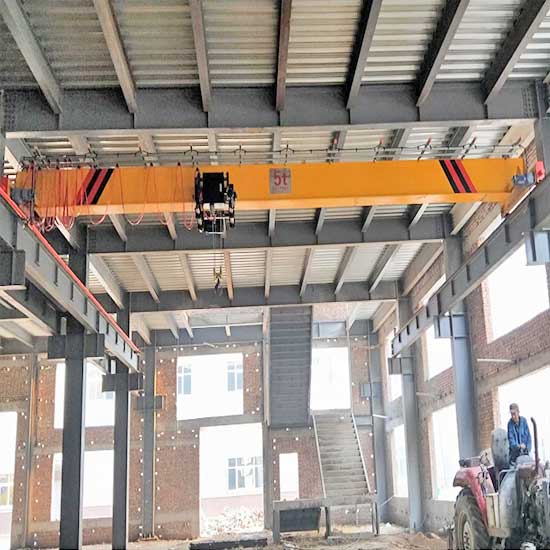
Single Girder Indoor Overhead Cranes: These are known for their simplicity and cost-effectiveness. They have one horizontal beam, or "girder," that supports the hoist and trolley. Single girder cranes are ideal for lighter loads and lower ceilings.
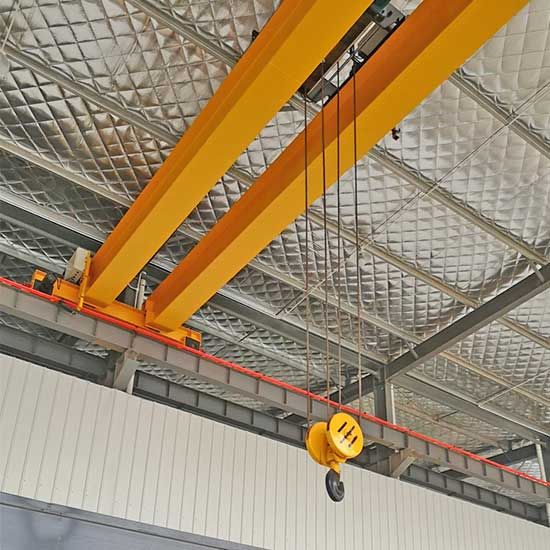
Double Girder Indoor Overhead Cranes: If your operation demands more lifting power and spans greater distances, double girder cranes are the choice. They feature two horizontal girders and offer enhanced stability and load capacity. Industries with heavy lifting requirements often opt for these workhorses.
Beyond the choice between single and double girder cranes, there's a spectrum of configurations to explore. The design and installation method can be tailored to your facility's unique needs.
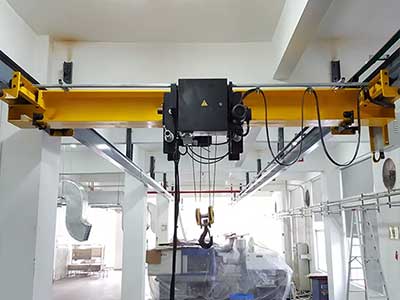
Underhung Indoor Overhead Cranes: These cranes are attached to the bottom flange of the building's support beams, leaving the floor area clear. They are a great choice for facilities with limited overhead space.
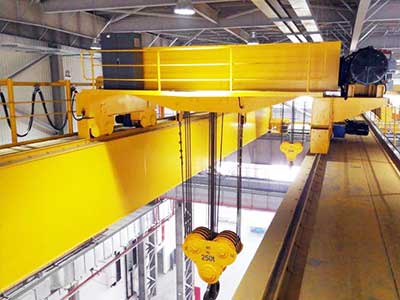
Top Running Indoor Overhead Cranes: Top runners are the go-to option for heavy-duty applications. They run on rails installed on the top of your building's structure, providing exceptional stability and load-bearing capacity.
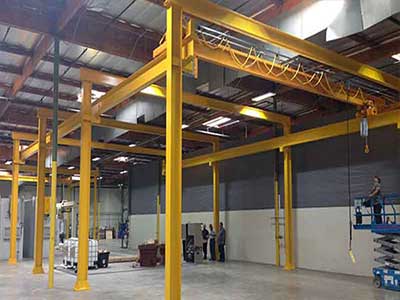
Freestanding Indoor Overhead Cranes: If you require flexibility in relocating your crane, freestanding options are your solution. These cranes are self-supporting and do not rely on the building's structure for support.
What are the main types of indoor overhead cranes
Indoor Overhead Cranes can be categorized based on various factors, including their Overhead Crane structures, mounting types, and typical applications. Here are some main types of indoor Overhead Cranes based on these criteria:
1. Based on Overhead Crane Structures:
a. Single Girder Overhead Crane:
- Structure: One horizontal beam (girder) spanning the width of the building.
- Mounting: Can be top running or under running.
- Applications: Light to moderate lifting in manufacturing, workshops, and warehouses.
b. Double Girder Overhead Crane:
- Structure: Two parallel horizontal beams (girders) for increased stability and lifting capacity.
- Mounting: Typically top running.
- Applications: Heavy-duty lifting in industries like steel manufacturing, foundries, and shipyards.
2. Based on Mounting Types:
a. Top Running Overhead Crane:
- Mounting: Bridge travels on top of runway beams.
- Applications: Versatile, suitable for various industries and heavy loads.
b. Under Running Overhead Crane (Underhung Crane):
- Mounting: Bridge travels beneath runway beams.
- Applications: Ideal for low-ceiling environments or where headroom is limited.
c. Gantry Crane:
- Mounting: Mounted on wheels or casters, moves along the floor.
- Applications: Suitable for locations where runway installation is not feasible, outdoor applications, or temporary setups.
3. Based on Typical Applications:
a. Jib Crane:
- Structure: Vertical mast with a horizontal jib or boom.
- Mounting: Fixed to the floor or wall, can also be freestanding.
- Applications: Localized lifting and material handling tasks in workstations, assembly lines, and maintenance areas.
b. Monorail Crane:
- Structure: Single rail or track along which a hoist and trolley move.
- Mounting: Typically top running.
- Applications: Linear material transport and various manufacturing processes.
c. Stacker Crane (Automated Storage and Retrieval System - AS/RS):
- Structure: Automated system with vertical and horizontal movement for pallet or container storage and retrieval.
- Mounting: Fixed rails within high-density storage facilities.
- Applications: Warehouses and distribution centers for efficient storage and retrieval.
d. Workstation Overhead Crane (or Free-Standing Overhead Crane):
- Structure: Smaller, portable crane designed for use in workstations or assembly lines.
- Mounting: Freestanding or mounted to the floor or ceiling.
- Applications: Material handling within specific work areas, maintenance tasks, and assembly processes.
The choice of the indoor Overhead Crane type depends on factors such as the load capacity required, available space, building structure, and the specific needs of the application. Different industries and settings may favor one type of crane over another based on their unique requirements for material handling and lifting tasks.
Masterful Engineering: Indoor Overhead Crane Features
Now that we've navigated the landscape of indoor Overhead Crane types, let's explore what makes these machines true engineering marvels.
- A. Precision and Power -Indoor Overhead Cranes are engineered for precision. With their advanced controls and technology, they can position heavy loads with utmost accuracy. Whether you're moving raw materials in a manufacturing plant or managing inventory in a warehouse, precision is key.
- B. Safety: Beyond Compromise -Safety is non-negotiable in any industrial setting, and indoor Overhead Cranes take it to heart. They come equipped with an array of safety features, such as overload protection, emergency stop systems, and collision avoidance technology. Your peace of mind and your team's safety are paramount.
- C. Tailoring Excellence -No two industries are the same, and neither should be your crane. Indoor Overhead Cranes offer customization options, allowing you to adapt them to your specific needs. From specialized hoists to unique control interfaces, the possibilities are limitless.
- D. Control at Your Fingertips -Modern indoor Overhead Cranes are user-friendly. With intuitive control systems, operators can maneuver loads with ease. Remote control and automation capabilities further enhance efficiency.
- E. The Lift You Need -Load capacity matters. Indoor Overhead Cranes come in various load-bearing capacities, ensuring you have the right tool for the job. Whether you're lifting a few hundred pounds or several tons, there's a crane to match your requirements.
Elevating Your Operations: Indoor Overhead Crane Benefits
Indoor Overhead Cranes are more than just machinery; they are transformative tools that can elevate your operations to new heights. In this section, we'll explore the multitude of benefits these cranes bring to the table.
- A. Turbocharging Efficiency -Efficiency is the lifeblood of any industrial operation, and indoor Overhead Cranes are the turbochargers. They enable swift and precise movement of materials, reducing downtime and bottlenecks. What used to take hours can now be accomplished in minutes, enhancing productivity across the board.
- B. The Guardian of Safety -Safety is paramount in any workplace, and indoor Overhead Cranes act as vigilant guardians. Equipped with advanced safety features, they minimize the risk of accidents. Overload protection, emergency stops, and collision avoidance technology are just a few examples of how these cranes ensure a secure working environment.
- C. Space Unleashed -Space is a precious commodity in industrial settings, and indoor Overhead Cranes unlock its true potential. By operating overhead, they free up valuable floor space that can be used for additional workstations, storage, or other essential functions. Say goodbye to clutter and congestion.
- D. Labor Savings Redefined -Indoor Overhead Cranes are not just machines; they are a cost-effective labor-saving solution. They reduce the physical strain on workers and minimize the need for manual labor in material handling. This not only boosts efficiency but also lowers labor costs.
- E. Craftsmanship in Handling -When it comes to handling delicate or intricate materials, indoor Overhead Cranes showcase their finesse. Their precision controls and smooth movements allow for delicate maneuvers, ensuring that even the most fragile items are handled with care. Whether you're in manufacturing, logistics, or a specialized industry, this level of craftsmanship is a game-changer.
Spotlight on Real-World Use: Indoor Overhead Crane Applications
Now that we've uncovered the remarkable benefits of indoor Overhead Cranes, let's shift our focus to their real-world applications. These versatile machines are the backbone of various industries, each type tailored to specific needs.
- A. Precision in Every Move: Single Girder -Precision manufacturing: Single girder indoor Overhead Cranes excel in precision manufacturing settings. They navigate tight spaces with ease, making them ideal for industries that demand accuracy, such as electronics assembly, small-parts manufacturing, and even in laboratories where delicate equipment handling is a must.
- B. Powering Heavy-Duty Operations: Double Girder -Heavy-duty lifting: When it comes to lifting substantial loads, double girder indoor Overhead Cranes take the spotlight. Industries dealing with large machinery, steel fabrication, or shipbuilding benefit from their robust design and high load capacity.
- C. Effortless Efficiency: Underhung Wonders -Space optimization: Underhung indoor Overhead Cranes are experts at optimizing space. Warehouses and distribution centers with high shelving systems rely on these cranes for smooth and efficient material movement. They allow you to make the most of vertical storage space.
- D. The Summit of Strength: Top Running Giants -Versatile strength: Top running indoor Overhead Cranes are versatile workhorses. They find their place in industries spanning from automotive manufacturing, where they lift heavy vehicle components, to lumber mills, handling large timber with ease. Their strength knows no bounds.
- E. Where Space Meets Crane: Freestanding Heroes -Flexibility in motion: Freestanding indoor Overhead Cranes offer mobility and adaptability. You'll find them in facilities where layouts change frequently, such as machine shops, where they can be easily relocated to accommodate evolving needs.
- F. Wall-Mounted Marvels -Space-saving excellence: Wall-mounted indoor Overhead Cranes are masters of space conservation. Industries like textiles, where floor space is at a premium, employ these cranes to maximize every inch. They keep the workspace clear while providing exceptional lifting capabilities.
As you can see, indoor Overhead Cranes are versatile and adaptable to a wide range of industries. Their ability to cater to unique needs makes them an indispensable asset in various settings. In our next segment, we'll explore the industrial applications where these cranes play a pivotal role. Stay tuned!
Where Strength Meets Industry: Indoor Overhead Crane Applications
Indoor Overhead Cranes are the unsung heroes of industry, silently powering various sectors with their strength and precision. Let's explore these real-world applications in more detail.
Indoor application of indoor Overhead Cranes
Indoor Overhead Cranes are widely used in various industrial applications to facilitate material handling, improve efficiency, and enhance workplace safety. Some of the key industrial applications of indoor Overhead Cranes include:
Manufacturing and Production:
- Overhead Cranes are used to transport raw materials, work-in-progress, and finished products within manufacturing facilities.
- They aid in positioning heavy components during assembly processes.
- Cranes can handle tasks like loading and unloading machinery, molds, and tooling.
Warehousing and Distribution:
- Indoor Overhead Cranes assist in the efficient movement of goods within warehouses and distribution centers.
- They are used for loading and unloading trucks and stacking or retrieving pallets from high-density storage systems.
Steel and Metal Fabrication:
- Overhead Cranes are essential for handling heavy steel coils, sheets, and structural components in steel mills and metal fabrication shops.
- They help with the movement of materials in cutting, welding, and machining processes.
Foundries:
- In foundries, Overhead Cranes are used to transport molten metal, molds, and heavy castings.
- They play a critical role in the safe and efficient operation of foundry equipment.
Automotive Industry:
- Indoor Overhead Cranes are used in automotive manufacturing plants for handling vehicle bodies, engines, and other components along assembly lines.
- They aid in material staging and positioning during the manufacturing process.
Shipbuilding and Maritime:
- Overhead Cranes are essential in shipyards for lifting and moving large ship sections, heavy machinery, and ship components.
- They facilitate the construction and maintenance of vessels.
Power Plants and Utilities:
- In power generation facilities, Overhead Cranes are used for maintenance of turbines, generators, and other heavy equipment.
- They assist in the installation of large power plant components.
Paper and Pulp Industry:
- Indoor Overhead Cranes are used in paper mills for handling paper rolls, pulp bales, and maintenance of machinery.
- They aid in material transport and storage.
Chemical and Petrochemical Plants:
- Overhead Cranes are used in these environments to handle heavy drums, vessels, and equipment.
- They assist in maintenance and process operations.
Food and Beverage Processing:
- In food processing and beverage production facilities, cranes are used for lifting and moving heavy ingredients, equipment, and finished products.
- They help maintain hygiene and efficiency in these environments.
Pharmaceutical and Healthcare Manufacturing:
- Overhead Cranes are employed for handling heavy machinery and materials in pharmaceutical manufacturing and healthcare product production.
Mining and Quarrying:
- In mining and quarry operations, cranes assist in the extraction, transport, and processing of heavy minerals, ores, and rocks.
Indoor Overhead Cranes are adaptable and customizable to suit the specific needs of these diverse industrial applications. They improve productivity, reduce manual labor, minimize the risk of accidents, and contribute to the overall efficiency and safety of industrial operations.
These applications highlight the adaptability and versatility of indoor Overhead Cranes across diverse industries. Their ability to optimize processes, enhance safety, and improve efficiency makes them indispensable in today's industrial landscape.
In our next segment, we'll delve into the cost and pricing considerations associated with indoor Overhead Cranes. Join us as we uncover the factors that influence crane costs and how to make informed investments.
Navigating the Price Horizon: Indoor Overhead Crane Costs
When considering the adoption of indoor Overhead Cranes, understanding the costs involved is essential. Let's delve into the financial aspects and equip you with the knowledge to make informed decisions.
A. The Price Equation
The cost of an indoor Overhead Crane can vary significantly based on several factors:
- 1. Type and Configuration: Different types of indoor Overhead Cranes come with varying price tags. Single girder cranes are generally more affordable than double girder ones. The specific configuration, such as top running or underhung, also affects the cost.
- 2. Load Capacity: The crane's load-bearing capacity directly impacts its cost. Higher load capacity requires more robust engineering, which can increase the overall price.
- 3. Span and Length: The crane's span and runway length influence the materials required for construction, affecting the cost. A longer span or runway will generally be more expensive.
- 4. Customization: Tailoring the crane to your specific needs can incur additional costs. Custom hoists, controls, and safety features may add to the overall price.
- 5. Installation: Proper installation is crucial for safety and performance. Installation costs can vary depending on factors like the complexity of the setup and site-specific requirements.
- 6. Maintenance Package: Some suppliers offer maintenance packages, which can add to the initial cost but provide long-term benefits in terms of crane reliability and longevity.
B. Investment Intelligence
Investing in an indoor Overhead Crane is not just an expenditure; it's an investment in your operations' efficiency and productivity. To make an intelligent investment:
- 1. Evaluate Your Needs: Start by understanding your specific material handling requirements. What type of loads will you be lifting? How frequently will you use the crane? Knowing your needs will help you choose the right crane type and capacity.
- 2. Total Cost of Ownership: Consider the total cost of ownership, which includes not only the purchase price but also operational costs, maintenance expenses, and potential downtime. A higher upfront investment may translate into lower long-term costs.
- 3. Supplier Reputation: Choose a reputable supplier with a track record of quality and reliability. A trusted supplier will provide not only a superior product but also excellent support and service.
- 4. Maintenance Plan: Factor in the cost of ongoing maintenance and inspections. A well-maintained crane not only ensures safety but also extends its lifespan, ultimately reducing long-term costs.
C. Counting the Maintenance Coin
Maintenance is an integral part of owning an indoor Overhead Crane. Regular inspections and upkeep are essential for safety and performance. Consider the following:
- 1. Scheduled Inspections: Budget for periodic inspections and maintenance activities as recommended by the manufacturer. These inspections help identify potential issues before they become costly problems.
- 2. Downtime Costs: Factor in the cost of downtime during maintenance and repairs. While planned maintenance is preferable, unexpected breakdowns can result in unplanned downtime expenses.
- 3. Maintenance Packages: Many suppliers offer maintenance packages that can be a cost-effective way to ensure the longevity and reliability of your crane. These packages often include regular inspections, parts replacement, and emergency support.
Addressing Key Concerns of Indoor Overhead Crane Users
As a responsible indoor Overhead Crane user, it's crucial to address several key concerns to ensure the safety, efficiency, and sustainability of your operations. Let's explore these concerns and how to navigate them effectively.
A. Safety on a Pedestal
Prioritizing safety: Safety should always be paramount when operating indoor Overhead Cranes. Ensure that your crane meets safety standards and regularly undergoes inspections. Train your personnel rigorously in safe crane operation and make sure they are equipped with the appropriate personal protective equipment (PPE). Safety should never be compromised.
B. Keeping the Pulse: Maintenance
Proactive maintenance: Regular maintenance is the lifeline of your indoor Overhead Crane. Create a maintenance schedule that includes routine inspections, lubrication, and component checks. Address issues promptly to prevent them from escalating and causing costly downtime. Consider partnering with a maintenance service provider to ensure the crane's longevity and reliability.
C. The Operator's Journey
Skilled operators: Invest in comprehensive training programs for crane operators. A skilled operator can make a significant difference in crane performance and safety. Regular training and certification should be part of your operational strategy to keep operators up-to-date with the latest industry standards and best practices.
D. Balancing the Load Equation
Load management: Proper load handling is vital for crane safety and efficiency. Always adhere to load capacity guidelines and ensure loads are balanced correctly. Overloading can lead to accidents and damage to your crane. Use load measuring devices if necessary to maintain precision and prevent overloading.
E. Green Crane: Energy Efficiency
Sustainable operations: In an era focused on sustainability, consider the energy efficiency of your indoor Overhead Crane. Modern cranes are designed with energy-saving features, such as regenerative braking systems and variable frequency drives. These not only reduce energy consumption but also lower operating costs.
Additionally, explore opportunities to optimize crane usage to reduce energy waste. This might include consolidating lifts or scheduling operations during off-peak energy hours.
Your Indoor Overhead Crane Queries Answered
In this section, we'll provide answers to some frequently asked questions about indoor Overhead Cranes, ensuring you have a comprehensive understanding of their operation and benefits.
A. Defining Limits: Maximum Load Capacity
Q: What is the maximum load capacity for indoor Overhead Cranes?
A: The maximum load capacity of an indoor Overhead Crane varies depending on its type and configuration. Single girder cranes typically handle loads from 1 to 20 tons, while double girder cranes can manage loads ranging from 5 to 300 tons or more. To determine the right load capacity for your needs, consult with a crane expert who can consider factors like your industry, application, and specific lifting requirements.
B. Keeping Watch: Inspection Insights
Q: How often should indoor Overhead Cranes be inspected?
A: Indoor Overhead Cranes should undergo regular inspections to ensure their safe and efficient operation. Here's a general guideline:
- 1. Daily Inspections: Operators should perform pre-shift inspections to check for any visible issues or abnormalities, including loose bolts, damaged wires, or unusual sounds.
- 2. Monthly Inspections: A more detailed monthly inspection should be conducted by trained personnel or a certified inspector. This examination should cover structural components, electrical systems, and safety features.
- 3. Annual Inspections: An annual comprehensive inspection by a qualified crane inspector is essential. This inspection delves into every aspect of the crane's operation and safety systems.
Remember that these are general guidelines. Local regulations and specific crane usage patterns may require more frequent inspections. Always follow the manufacturer's recommendations and consult with an expert to establish an inspection schedule.
C. Shifting Spaces: Crane Relocation
Q: Can indoor Overhead Cranes be relocated within a facility?
A: Yes, indoor Overhead Cranes can often be relocated within a facility, provided the new location complies with structural and operational requirements. The feasibility of relocation depends on factors like the crane type, runway configuration, and the new space's structural capacity. Relocation should always be carried out by experienced professionals to ensure safety and compliance with regulations.
D. Eco-Caring Cranes
Q: Are there any environmental considerations when using indoor Overhead Cranes?
A: Absolutely. Environmental responsibility is increasingly important in industrial settings. Many modern indoor Overhead Cranes are designed with energy-efficient features, such as regenerative braking and variable frequency drives, to reduce energy consumption. Additionally, proper maintenance practices can minimize the environmental impact by extending the crane's lifespan and reducing the need for replacements.
E. Beyond Basics: Safety Features
Q: What safety features are typically included in indoor Overhead Cranes?
A: Indoor Overhead Cranes are equipped with a range of safety features to protect both personnel and equipment. Common safety features include:
Overload Protection: Prevents the crane from lifting loads beyond its capacity.
- Emergency Stop: Allows for immediate shutdown in case of an emergency.
- Collision Avoidance Systems: Detects potential collisions and stops or adjusts crane movement.
- Limit Switches: Prevents over-travel of the crane along the runway.
- Load Measurement Devices: Provides real-time load information to ensure safe lifting.
These safety features, among others, are essential components of indoor Overhead Cranes, contributing to safe and efficient operation.
Contact Us: Partnering with You
Thank you for embarking on this journey through the world of indoor Overhead Cranes with us. We're here to be your trusted partner in enhancing your operations and material handling efficiency.
A. Elevate Your Operations
Ready to take your operations to new heights with the power of indoor Overhead Cranes? Our expert team is dedicated to understanding your unique needs, recommending the perfect crane solution, and ensuring seamless integration into your facility.
Whether you're looking to boost manufacturing precision, optimize warehousing efficiency, or tackle heavy-duty lifting challenges, we have the expertise and a range of crane options to meet your goals.
Our commitment to safety, quality, and customer satisfaction means you can trust us to deliver the best indoor Overhead Crane solutions tailored to your specific industry and application.
B. Reach Out – We've Got You Covered
Don't hesitate to get in touch with us today. Your journey to improved productivity and streamlined material handling begins with a conversation. We're here to answer your questions, provide detailed information, and offer expert guidance.
Our team of specialists is just a phone call or email away, ready to assist you in finding the perfect indoor Overhead Crane solution. Let's work together to transform your operations and elevate your success.
Partner with us, and discover the difference that a reliable, efficient, and safe indoor Overhead Crane can make for your business. We look forward to hearing from you soon.
Related Products

Latest project
150 Ton Overhead Crane Installation Feedback – Paraguay Case
QDX 150 ton overhead crane in action in Paraguay. Installation photos, video, and client feedback show performance, safety, and heavy-lifting efficiency.
Free consultation to Confirm Parameters & Specifications and Get
Latest Crane Price & Crane Rate.
- Types of overhead cranes : _______?
- Optional: Overhead travelling crane, goliath gantry crane,Slewing jib crane, Single girder or double girder crane,small portable crane or kbk crane, etc.
- Capacity of overhead crane: _______?
- Optional: 0.25ton, 0.5 ton, 1 ton, 2 ton, 3ton, 5 ton, 10 ton,15ton, 20ton, 25 ton, 30ton,35ton, up to 550ton, etc.
- Crane span & lifting height : _______?
- Crane travelling length : _____?
- Control of overhead crane:_______?
- Optional: pendant/ remote/cabin control
- Voltage supply of overhead crane:_____?
- Eg,: 380V50/60HZ,3Phase or others,etc.
- Application/usage of crane:_______?
- Eg,: Steel mill, ,injection mold, cement,stone, concrete,granite, general manufacturing, etc.
Just leave a message via the contact form and our hoist and crane engineer will contact you with in 24working hours.
Get In Touch
